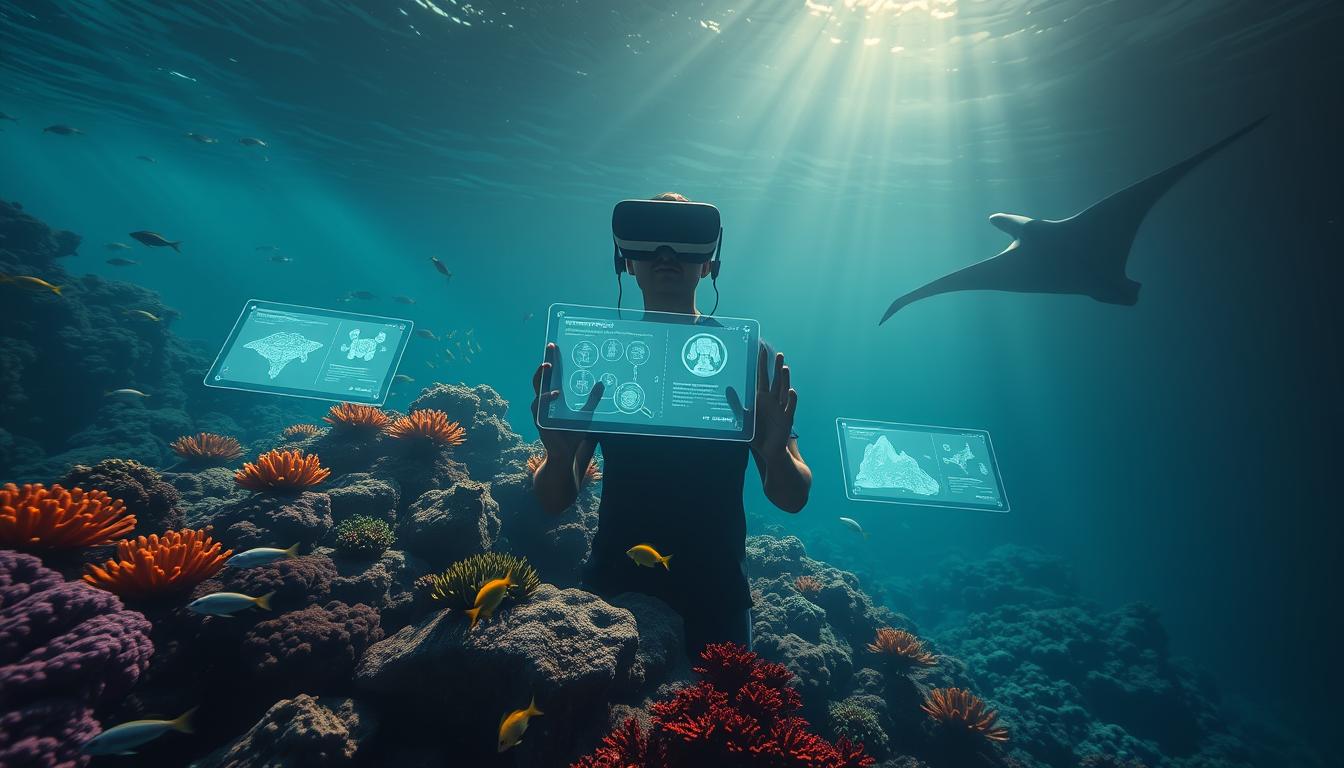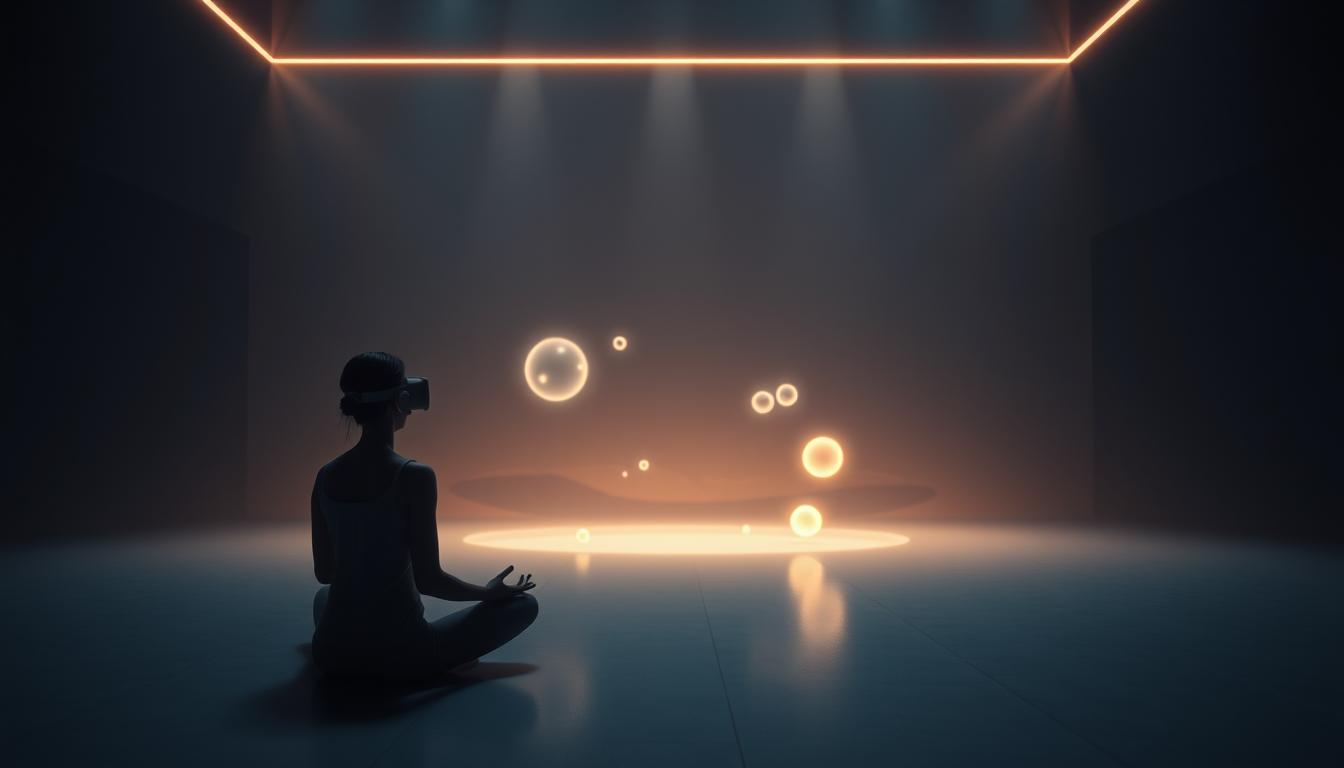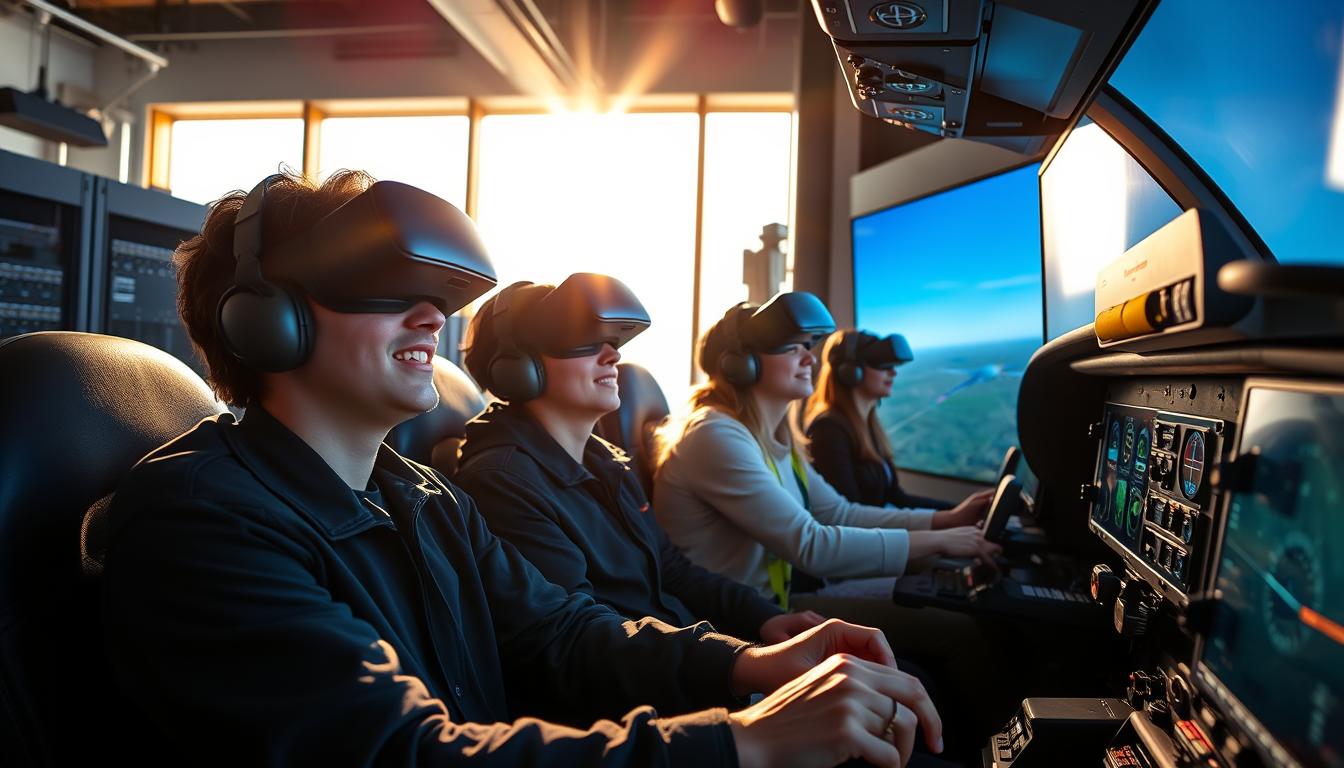Could virtual reality be the missing link in your hand rehabilitation journey? As technology advances, VR games designed for physical therapy are stepping into the spotlight. They offer innovative solutions for individuals seeking recovery after strokes or those with impaired fine motor skills.
In this article, we will explore the best VR games specifically tailored for hand rehabilitation. We’ll see how they can significantly enhance motor function and aid recovery. Join us as we delve into the world of VR therapy. Discover how these interactive experiences are transforming physical therapy programs.
Introduction to VR in Physical Therapy
Virtual reality is changing physical therapy in big ways. It brings new life to traditional therapy by making it more fun and engaging. Patients get to explore virtual worlds, which makes their recovery journey more enjoyable and effective.
Therapists are seeing better results as they use VR tools. Patients are more motivated and excited to do their exercises. This new approach is not just about technology. It’s about making patients feel better in every way.
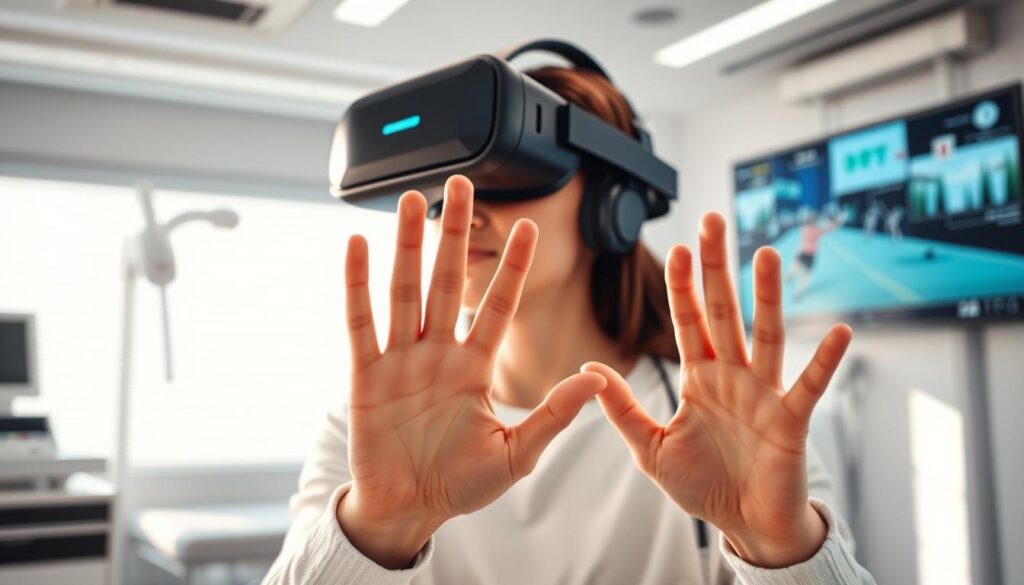
Understanding Hand Rehabilitation
Hand rehabilitation is key for those recovering from a stroke or motor impairments. It helps improve hand function and independence. This is crucial for daily tasks.
Effective hand rehab restores fine motor skills and hand coordination. It makes it easier to do everyday activities.
Therapy techniques include task-specific practice and repetitive motions. These help build muscle memory and improve function. Adaptive techniques are also used to meet individual needs.
Hand rehab not only trains the brain and body but also boosts confidence. Seeing progress in stroke recovery motivates patients. It helps them regain full hand use and live more independently.
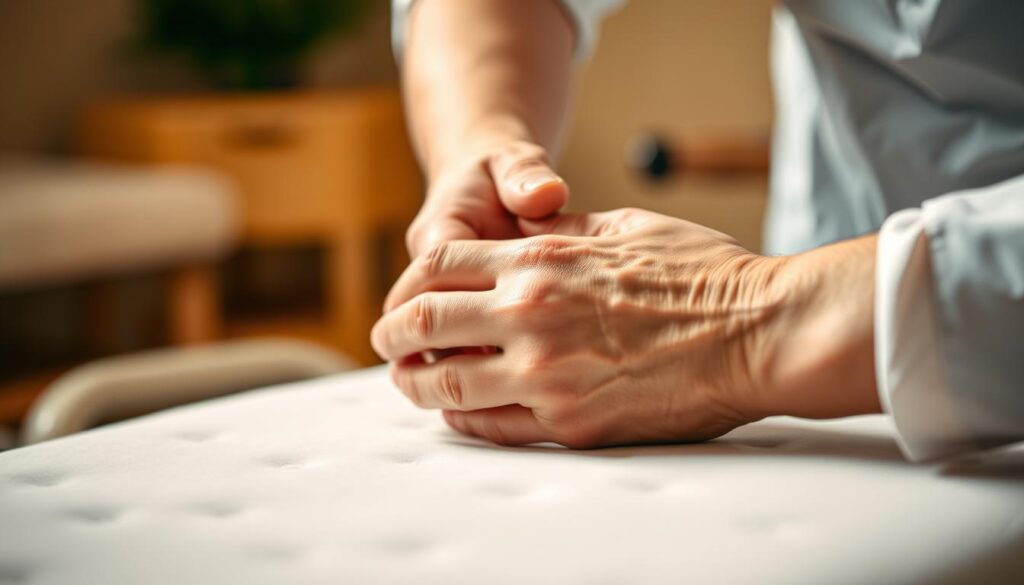
Why Choose Virtual Reality Games for Hand Rehabilitation
Virtual reality (VR) games offer special benefits for hand rehabilitation. They are a great choice for both patients and therapists. The main treatment advantage of VR therapy is its interactive and immersive environment. This makes therapy more engaging than traditional methods, which can be dull and repetitive.
VR rehabilitation games can be tailored to fit different skill levels. This allows for personalized experiences that meet each patient’s needs. It encourages patients to challenge themselves, which helps improve their motor skills. The game-like nature of therapy makes it fun and boosts motivation, as patients earn rewards for their progress.
VR therapy also provides real-time feedback, which is a big plus. Patients can see how they’re doing right away, which helps them understand their movements better. This feature helps improve motor coordination and dexterity. Using VR systems makes patients feel a sense of achievement, which keeps them interested in therapy.
Benefits of VR Therapy for Stroke Survivors
VR therapy is a new way to help stroke survivors get better. It makes therapy fun and engaging. This helps patients stay motivated and keep up with their treatment.
Engagement and Motivation
VR therapy grabs the attention of stroke survivors. It turns boring exercises into exciting games. This makes patients more determined and helps them recover faster.
It uses a game-like approach to keep patients focused on their recovery. This makes them more committed to getting better.
Improvement in Fine Motor Skills
VR therapy also boosts fine motor skills. It offers exercises in virtual worlds that improve dexterity and coordination. These exercises are like real-life tasks, helping patients practice in a practical way.
This focused practice leads to better motor skills. It’s key for helping patients become independent in their daily lives.
Top VR Games for Hand Rehabilitation
Virtual reality has changed hand rehabilitation. It offers fun and interactive ways to recover. The best VR games help improve motor skills and keep users motivated.
Some games stand out for their impact on rehabilitation. They make a big difference in how well users recover.
Overview of Popular Options
MindMaze and FitMi are top games for hand rehab. They have activities that make improving hand movements fun and different.
| Game Title | Focus Area | User Engagement | Effectiveness |
|---|---|---|---|
| MindMaze | Cognitive and motor skills | Highly engaging with narrative elements | Proven to enhance fine motor skills |
| FitMi | Repetitive movements for strength | Interactive music and feedback | Boosts hand strength and coordination |
Users can find games that fit their needs in the best VR games. These games mix physical tasks with fun environments. This makes hand rehabilitation both effective and fun.
Virtual reality games for hand rehabilitation
Virtual reality games are a big step forward in hand therapy. They make physical therapy fun and interactive. These games help improve hand strength, coordination, and arm function.
They use special technology to create real-like experiences. This encourages patients to take an active role in their recovery.
VR games are great for different patients. They help those recovering from strokes, injuries, or other hand mobility issues. Some games strengthen hand muscles with repetitive movements. Others improve fine motor skills with challenges.
These games mimic real tasks, helping users practice daily activities. They give feedback in real-time, so patients can see how they’re doing. This makes therapy more fun and helps patients stick to their routines.
More doctors are using VR games in treatment plans. This shows promise for better patient results. With these tools, therapists can tailor care to each person’s needs. This leads to a more effective recovery.
How VR Games Enhance Motor Function
Virtual reality (VR) therapy is a powerful tool for improving motor function. It works by enhancing neuroplasticity. This method lets users practice basic movements in a fun way.
These games help people do important tasks that aid in recovery. They also make neural pathways stronger.
VR therapy offers personalized experiences for each user. It helps retrain motor skills, boosting coordination and strength. Players face virtual challenges that strengthen brain connections needed for motor function.
VR therapy combines fun games with therapy exercises. This makes rehab more enjoyable and keeps users motivated. It’s key for lasting improvements in motor function.
Game Features that Aid Recovery
Understanding the key game features in VR therapy is crucial for hand rehabilitation. These elements make recovery support more immersive and engaging. They help improve the therapeutic experience and patient outcomes.
Real-Time Feedback Systems
Real-time feedback systems are a big plus in VR therapy. They give users instant feedback on their performance. This lets them adjust their movements and techniques right away.
This immediate feedback helps users learn tasks faster. It ensures they keep improving in their rehabilitation.
Task-Specific Training Simulations
Task-specific training simulations are vital for a tailored rehabilitation experience. They create real-life scenarios for patients to practice in a safe space. This training boosts motor function and confidence.
It makes the transition to real-world tasks smoother and more effective.
Targeted VR Games for Upper Limb Coordination
Improving upper limb coordination is key for those recovering from motor impairments. Targeted VR games offer fun ways to help with this. They let patients practice and improve their movements. This shows how virtual reality can make physical therapy more fun and effective.
Examples of Effective VR Games
- Beat Saber: This rhythm game has players slice blocks to the beat. It helps improve movement skills needed for daily tasks.
- Oculus Quest Sports: It simulates sports activities, boosting hand-eye coordination and arm movement.
- Fruit Ninja VR: Players use virtual swords to cut fruit, enhancing quick reflexes and precise movements. It’s great for stroke survivors to regain coordination.
- Dance Central VR: Dancing games like this one help improve coordination through song and rhythm. They make movement fun and repetitive.
These VR games are just a few examples for rehabilitation. Each game makes practicing movements fun. This helps improve upper limb coordination and aids in recovery.
Technology and Equipment Needed
To start VR therapy, you need special tech and gear for good results. High-quality VR headsets are key for a deep experience. The Oculus Quest 2 is a top pick because of its design and features, perfect for therapy.
Motion sensors are crucial for tracking patients’ movements during therapy. They work with the VR gear to make interactive environments. This boosts patient engagement and interaction.
For a full setup, you might add handheld controllers and software for different exercises. This helps with hand rehab and keeps patients motivated and moving forward.
Implementation in Physical Therapy Settings
Using virtual reality (VR) games in physical therapy is a new way to help patients. It makes therapy more fun and gets patients involved in their recovery. Mixing VR games with traditional therapy can lead to better results.
Combining VR Games with Traditional Therapy Techniques
VR therapy and old-school methods work well together. Hands-on therapy builds basic skills, while VR games offer fun ways to practice. This mix helps patients recover fully, both physically and mentally.
Monitoring Progress and Adjustments
Keeping track of how well therapy is working is key. VR games help therapists see how patients are improving. This lets them change the therapy plan to fit each patient’s needs better.
By checking progress often, therapists can make sure patients get the best care. They can decide when to make exercises harder or change how they’re done. This helps patients get the most out of their therapy.
Success Stories from VR Rehabilitation
Real-life success stories show how VR rehabilitation can change lives. People recovering from injuries have seen big improvements. A stroke survivor, for example, gained a lot of dexterity thanks to a special VR program.
These stories are part of a bigger trend. People say VR makes therapy more fun and motivating. This makes them more eager to keep going with their rehab.
Another story is about a patient with a brain injury. She was able to get back her fine motor skills. The VR program gave her feedback right away, which helped her stay focused and committed.
These stories highlight VR’s power in helping people recover. They show how it can lead to new and better ways to help with hand movement problems.
Challenges and Limitations of VR Therapy
VR therapy is a new way to help people recover, but it has its own set of problems. One big issue is the cost of VR gear. This can be too expensive for many rehab centers.
Another big problem is technology barriers. Some patients might not feel comfortable with new tech. Also, technical problems can ruin therapy sessions, causing frustration for everyone involved.
It’s crucial to have well-trained therapists for VR therapy to work. They need to know how to use VR tools for hand rehab. Without the right training, VR therapy might not help as much as hoped.
Some people might get motion sickness or feel uncomfortable with VR. It’s important to pick the right patients for VR therapy. A careful check ensures the therapy fits each patient’s needs and abilities.
Future of VR in Hand Rehabilitation
Technology keeps getting better, and VR in rehab looks bright. We’ll see better user interfaces and more realistic therapy sessions. Soon, VR will use artificial intelligence to make therapy plans just for you.
These changes aim to make rehab more fun and engaging. Realistic simulations will get patients excited about their recovery. This mix of fun and personalized care will change rehab a lot.
Soon, VR will add game-like elements to therapy. This will make rehab fun while helping patients reach their goals. It’s a big change for hand rehab.
VR is changing rehab for the better. As more doctors use VR, rehab will help more people. This will make a big difference in people’s lives.
Conclusion
Virtual reality (VR) games in hand rehabilitation are a big step forward. VR therapy makes patients more involved and motivated. This is key for a better recovery experience.
VR helps improve fine motor skills and hand function. It offers a fun, personalized way to practice exercises. This makes therapy more effective and engaging.
VR therapy is changing hand rehabilitation for the better. It makes treatment more engaging and effective. This is great news for both therapists and patients.
FAQ
What are the best VR games for hand rehabilitation?
Top VR games for hand rehab include MindMaze and FitMi. They boost motor skills with fun tasks. These games help in recovering hand strength and dexterity.
How does VR therapy help stroke survivors?
VR therapy keeps stroke survivors engaged and motivated. It’s key for their recovery. It helps them practice fine motor skills through real-life tasks, improving dexterity and coordination.
What technology is required for VR therapy?
You need VR headsets like the Oculus Quest 2 and motion sensors. These tools track movements accurately. They’re crucial for a full VR therapy experience.
Can VR games be integrated into traditional therapy?
Yes, VR games can add to traditional physical therapy. They make recovery more engaging and effective. This mix ensures a comprehensive rehabilitation plan.
What are the potential challenges of VR therapy?
VR therapy faces challenges like tech barriers, costs, and training needs. It’s vital for therapists and patients to be aware of these. This knowledge helps maximize VR therapy’s benefits.
How does neuroplasticity relate to VR therapy?
Neuroplasticity lets the brain adapt, and VR therapy boosts this. It offers repetitive exercises and engaging gameplay. This helps in recovery and rebuilding neural paths.
What are the benefits of using VR for fine motor skills development?
VR therapy is a unique way to improve fine motor skills. It makes therapy fun and immersive. This motivates patients, leading to better hand movements and overall function.
What is task-specific training in VR games?
Task-specific training in VR games simulates real-world tasks. It helps patients practice hand coordination and strength safely. This tailored approach makes therapy more effective.


